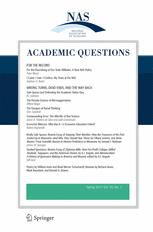Michelle Marder Kamhi is an independent scholar and critic and co-edits Aristos, an online review of the arts. Her latest book is Bucking the Artworld Tide: Reflections on Art, Pseudo Art, Art Education & Theory (Pro Arte Books, 2020); www.mmkamhi.com. Kamhi last contributed to Academic Questions with “The Lamentable Politicization of Art,” in the Winter, 2020 issue.
Medical students are prudently taught to guard against the “Semmelweis reflex.” Also known as the “Semmelweis effect,” it is the tendency to automatically reject new information or knowledge that contradicts prevailing norms or beliefs. The caveat stems from one of the most notorious debacles in the history of medicine. But it is applicable to any area of human knowledge. It is worth briefly recounting the facts of the case here for the light they shed on the nature of the phenomenon.
Ignaz Semmelweis’s Cautionary Tale
As a young Hungarian doctor serving in the maternity ward of mid-nineteenth-century Vienna’s most prestigious hospital, Ignaz Semmelweis (1818–1865) made an astonishingly simple life-saving discovery. Although the germ theory of disease had not yet been established, he reasoned that doctors who went directly from performing autopsies to examining maternity patients in the hospital’s First Obstetrical Clinic were somehow transmitting infection to those women—who were dying at alarmingly high rates compared to poorer patients in the Second Clinic, who were attended by midwives rather than doctors. When he ordered doctors to wash their hands in a chlorinated lime solution before examining patients, the mortality from childbed fever dropped precipitously.
Despite such overwhelming evidence in support of the practice, the medical establishment resisted adopting the measure for years. Because Semmelweis could not explain the underlying mechanism, skeptical doctors looked to other causes. Having improved ventilation in response to the long-held notion that the infection was spread by miasmas, for example, they alleged that the drop in mortality was due to that factor. Professional reputations were on the line, after all. Established physicians in “advanced” Austria were not about to be bested by a young upstart from its culturally “backward” dependency Hungary. Moreover, the idea that the hands of gentlemen doctors were unclean was perceived by some as an insult. Still worse, accepting the hand-washing measure implied that they were responsible for the countless deaths that had already occurred. Finally, politics too were a factor. When Hungary rose up against Austria in 1848, Semmelweis was further suspect. Though some of his medical peers warmly supported him, those in charge demoted him professionally and severely restricted his obstetrical practice.
By 1850, Semmelweis fled Vienna in despair, and returned to his native city of Pest. There, he was able to fully implement his hand-washing policy at a small maternity clinic and later at the University of Pest, where he became professor of obstetrics. Once again, maternity-related mortality plummeted. Elsewhere, however, women continued to die needlessly for nearly two decades, until the germ theory of infection ultimately vindicated Semmelweis’s practice. Sadly, he did not live to see that day.
The Perseverance of Belief in the Artworld
In efforts to challenge the reigning paradigms in the contemporary artworld, I’ve witnessed the Semmelweis reflex writ large. Most telling has been the reaction among academic philosophers of art. Two decades ago, when Louis Torres and I published What Art Is: The Esthetic Theory of Ayn Rand (2000)—questioning the dominant artworld view that virtually anything could qualify as art—neither of the two most relevant academic journals reviewed it. When I inquired if the Journal of Aesthetic Education had scheduled it for review, the editor confided that she considered it an important book and had tried hard to find a reviewer, but the connection to Rand had deterred every academic she approached from even looking at our book. The Journal of Aesthetics and Art Criticism offered no reason for its rejection, other than the platitude of receiving more books than it can review. Yet around the same time, it saw fit to review a book on the aesthetics of the Japanese lunch box.
Since Rand’s theory of art was virtually unknown beyond the circle of her admirers, it is safe to say that the anti-Randian animus we encountered was due to her controversial political views. When the JAE editor kindly asked if I could suggest a reviewer, I therefore recommended Denis Dutton, the philosopher of art who had co-founded the pioneering web portal Arts & Letters Daily in 1998 and whose libertarian leanings were well known. To our disappointment, however, Dutton too declined. As we subsequently learned through correspondence with him following the publication of his book The Art Instinct (Bloomsbury Press, 2009), he was familiar with Rand’s theory but had summarily rejected it. Repelled by her idiosyncratic pronouncements regarding particular works and styles of art—obiter dicta that we too have criticized as outrageously wrong-headed1 —he was unable to see beyond them to find merit in the broad principles of her theory. Having made up his mind on that score, he was not about to reconsider the matter. Remarkably, unlike us, he vehemently (if incoherently) defended Marcel Duchamp’s notorious “readymade” Fountain not only as a work of art but as one of “genius.”2
Daring to Question Abstract Art
To our great surprise, What Art Is was reviewed in the journal thePublic Interest (Spring, 2001), by Roger Kimball, then managing editor of the New Criterion. As was clear from an op-ed published a decade earlier that we had cited in our introduction, Irving Kristol (co-founding co-editor of the Public Interest) was strongly disposed to favor our censure of the contemporary artworld and our defense of traditional art.3 But Kimball dismissed our defense of Rand’s view that art could be objectively defined, quoting Immanuel Kant’s observation that “there can be no objective rule of taste which shall determine by means of concepts what is beautiful.” That dictum is from an early section of Kant’s Critique of Judgment, discussing taste in general, however.4 In a later portion, dealing with art per se, Kant argues that the value of a work depends not simply on its beauty but on its presenting “aesthetical Ideas”—by which he means perceptual embodiments of important concepts. As he explains, they are representations based on the imaginative imitation of nature. That view is strikingly similar to Rand’s view that, through the “selective re-creation of reality,” art “brings man’s concepts to the perceptual level of his consciousness and allows him to grasp them directly, as if they were percepts”—which she stipulated as the crux of her Objectivist esthetics. Thus, Kant offers a corroboration of Rand’s view regarding the essential nature of art, not a rebuttal. Most important, Kant’s view implicitly excludes “abstract art,” which entirely abandoned representation.5
Our insistence that the fine arts (as contrasted with the decorative arts) are essentially mimetic—thereby precluding abstract painting and sculpture—has also been a bitter pill for academic philosophers of art to swallow. The art status of such work is firmly entrenched for them. Nearly a decade before the publication of What Art Is, one of them had asserted in the Blackwell reference work A Companion to Aesthetics: “[A]bstract art has undoubtedly performed [one conspicuous service] for philosophy; it has dealt the death blow to the ancient views that art is the imitation or the idealization of the real world.” The writer further supposed that “hardly anyone will at this point be perverse enough to deny [that abstract works can be art].”
Being that perverse was of course bound to meet with resistance. Most telling in that regard was the response of a presumably expert referee to a paper I submitted to the Journal of Aesthetics and Art Criticism. Entitled “Why Discarding the Concept of ‘Fine Art’ Has Been a Grave Error,” the paper argued, in part, that the essentially mimetic nature of the fine arts was strongly supported by classicist Stephen Halliwell’s account of ancient thought on the subject in his masterly study The Aesthetics of Mimesis. The JAAC referee demurred, claiming that my use of Halliwell was the weakest part of my argument. In the referee’s view, Halliwell’s account of mimesis was “a very flexible notion,” not only “readily applicable” to abstract work such as the paintings of Kandinsky but to architecture as well.
Convinced that the referee’s view was mistaken, I wrote to Halliwell. He replied that he “did indeed argue that mimesis was a more ‘flexible’ concept in ancient texts than has often been appreciated, but certainly not to the point of suggesting that it could encompass anything like abstract art.”6 As for that referee’s point about architecture, other referees, in contrast, found my argument against the misguided inclusion of architecture among the “fine arts” persuasive and worth publishing.7
Noting those points in a “Response to JAAC on Discarding ‘Fine Art,’” I forwarded it to the journal co-editors, along with my correspondence with Halliwell, and requested that the items be forwarded to the referees for their information. In addition, I objected to not having been sent the full report by the paper’s second referee—who had argued in part that my approach was “a-historical” and appeared “reverse-engineered for the purpose of condemning anti-traditional forms.”
One of the co-editors, Theodore Gracyk (Professor of Philosophy at Minnesota State University Moorhead), responded:
[T]he question of Halliwell’s scholarship was [only] one factor among several in our decision to decline the paper. Concerning the brevity of the report from the second referee, it is not unusual for a referee to withhold some of their comments from the author, especially when their report is negative.
So much for transparency in academia.
With Semmelweis’s example to inspire me, however, I published the essay online in Aristos—along with my response to the JAAC and one to the British Journal of Aesthetics, which had rejected an earlier version of the same paper.8 And I continue to press on, in the hope that truth will ultimately prevail over presumed expertise.
1 See, for example, What Art Is, 53, 55; and my talk “Understanding and Appreciating Art,” https://www.youtube.com/watch?v=99Ja_APzPHE, published in Bucking the Artworld Tide (Pro Arte Books, 2020), 41–53.
2 See Louis Torres’s review of The Art Instinct: “What Makes Art Art? Does Denis Dutton Know?,” Aristos (April 2010), https://www.aristos.org/aris-10/dutton.htm.
3 Irving Kristol, “It’s Obscene but Is It Art?” Wall Street Journal, August 7, 1990.
4 “Response to Public Interest review,” n.d., https://www.aristos.org/editors/resp-pi.htm
5 See my article “Hilton Kramer’s Misreading of Abstract Art,” Aristos, May 2003, https://www.aristos.org/aris-03/kramer.htm.
6 Stephen Halliwell, email communication, January 16, 2017.
7 For a summary of the argument regarding architecture, see “Defining the Fine Arts,” https://www.nas.org/blogs/article/defining_the_fine_arts12.
8 “Why Discarding the Concept of ‘Fine Art’ Has Been a Grave Error,” Aristos, April 2017, https://www.aristos.org/aris-17/discardingfineart.htm.
Recommended citation: Michelle Marder Kamhi. "Beware the Semmelweis Reflex.” Academic Questions 34, no. 1 (Spring 2021): Page 70–Page 74.














